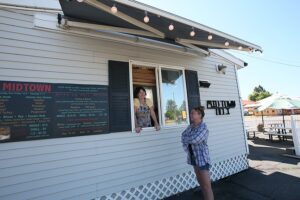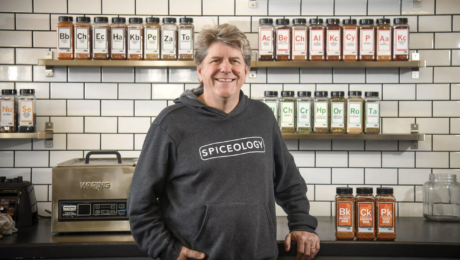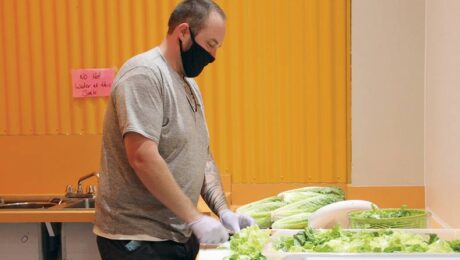Spokane-based Spiceology raises $4.7 million in Series A funding
Spokane-based Spiceology has secured a $4.7 million round of Series A funding, led by grocery and retail executive Ty Bennett with participation by Kickstart Funds III and IV, a group of angel investors and the Cowles Co., which publishes The Spokesman-Review.
“I have been an investor in Spiceology since the early days and had the privilege of watching the company elevate above the thousands of small spice purveyors in the market,” Ty Bennett, founder and former CEO of Jacent, said in a statement. “I look forward to bringing my retail and grocery experience to the table to help Spiceology continue to delight customers and find new ways of meeting customers where they shop.”
The privately held spice company will use the funding to bring process automation to its SpiceLab operations, and advance its sales and marketing efforts. The SpiceLab is where spice blends are formulated and packaged with the company’s trademarked “periodic table of flavor” labels, according to a company release.
Series A funding is the first round of investment funding after seed funding. It typically involves venture capital firms and is for startups that have established growth.
Spiceology, founded in 2013, was recently named to Inc. Magazine’s list of the 5,000 fastest-growing companies in the nation. It ranked 1,081 on the list with a three-year revenue growth of 423%.
The company has steadily grown its operations by creating recipes and how-to videos for customers as well as collaborating with chefs and food influencers on new product lines.
At the onset of the coronavirus pandemic, Spiceology experienced an uptick in spice sales as more people began preparing meals at home.
Bennett has joined Spiceology’s board of directors. The company also hired Roger Landrum as senior vice president of global supply chain and operations, the release said.
Landrum was formerly the senior director of supply chain, risk management and procurement at Litehouse Foods, a Sandpoint-based $300 million salad dressing and herb manufacturer.
“Spiceology’s formula is focusing on quality and innovation at scale. By doing so, we’re bringing life into a very tired category that’s sorely in need of a fresh alternative,” Chip Overstreet, president and CEO of Spiceology, said in a statement.
“There’s nothing more core to our lives than eating, and we bring smiles to people’s faces when they realize how much better every meal can be with a simple sprinkle of Spiceology goodness.”
- Published in News + Updates
Colville’s cross laminated timber manufacturer will help put region on CLT map
This article originally appeared on KXLY.com by Derek Deis
COLVILLE, Wash. — Buildings made with cross laminated timber are already commonplace in Europe, but it’s a relatively new concept here. So to say Russ Vaagen, whose family has owned Vaagen Brothers Lumber for more than 70 years, is excited about his new venture would be an understatement.
“We could put this as the mass timber capital of North America eventually,” said Vaagen, the CEO and founder of Vaagen Timbers.
Cross laminated timber is an eco-friendly, wood panel product made from gluing layers of lumber together. Vaagen says it’s kind of like a Lego set.
“We’re actually putting together a kit that a builder can do very rapidly, high quality and goes together the same way every time,” explained Vaagen. “And so, it’s going to speed construction time up, it’s going to provide a much higher quality build, we’re going to be much more energy efficient.”
Vaagen Timbers can build its CLT panels up to 60 feet wide with varying depths. And Vaagen says it’s one-fifth the weight of steel and concrete with the same structural strength.
“So we’ll have a lighter, more nimble building. It’ll also be much better equipped to handle seismic shifts.”
And Vaagen says it can be used for all sorts of applications, including, “Mid-rise structures for commercial buildings, apartments and even homes.”
CLT panels start with pieces of lumber on the finger jointer machine.
“We take knives and we make a set of fingers. And they do just as it says, they joint together. And then we use pressure and an adhesive to tie those together,” said Vaagen.
After the wood is planed, it goes to the layup line, where Vaagen says those pieces of lumber get turned into panels.
“So we take four feet of wood, we lift it up all together, put it on the conveyor, goes and gets a layer of glue.”
A set of vacuums then lifts and places each additional layer.
“Sets it on top of that glued layer 90 degrees to the other layer, comes back through the glue, gets another long layer set back on it.”
The now heat cured panels then get cut by giant saws on the CNC line.
“We’re cleaning the cuts, we’re making the connections to go panel to panel if we’re doing a wall or a floor system,” said Vaagen.
After sanding, they’re ready to be shipped to customers.
One of the first places you’ll be able to see Vaagen Timbers’ CLT put to use is in Spokane’s Perry District, where Blockhouse – Life is building a 14 unit modular structure using CLT.”
“So we’ll make boxes basically that can be repeatable, but they can be customized,” said Vaagen. “And it’s modular. So ultimately, you could pick it up and move it and put it someplace else.”
Vaagen says Spokane, and Washington as a whole, are poised to be leaders in CLT and mass timber products. And that has him excited about Vaagen Timbers’ potential for growth.
“There’s just no losers. Everybody wins. And we’re going to be offering incredible structures for people to build with for years to come.”
- Published in News + Updates
Inland Northwest Economic Developments, SUMMER 2020
The following are projects, initiatives and economic developments are making news in eastern Washington and northern Idaho.
*************
SPOKANE, Wash. — Washington Department of Commerce has provided a $100,000 grant to support expansion and workforce training needs of SkyOne Aerospace. Founded in the Spokane Valley in 2015 with three employees, SkyOne Aerospace, specializes in customer-oriented repair and overhaul of instruments, avionics, electronics, mechanical units and hydraulic units of military aerospace aftermarket. SkyOne will purchase new equipment to meet expansion needs and hire additional skilled technicians with military aerospace experience. The company will retain 18 jobs and create 45 new jobs over the course of the next three years. Presently, 40 percent of SkyOne’s workforce are veterans, and the company is committed to hiring more, mostly from Fairchild Airforce Base. Read more on the SkyOne website.
COEUR d’ALENE, Idaho — Idaho Central Credit Union, ranked 2nd by Forbes’ 2020 Customer Satisfaction Survey, opened a branch in Coeur d’Alene at 1327 W. Appleway Avenue. This is Idaho Central’s 38th location in Idaho. The 8,600-square-foot branch has a drive-through with three lanes, an ATM and a video booth in the corner for members to access our VideoChat services. See more about ICCU’s Appleway Branch here.
PULLMAN, Wash. — With the recent successful completion of the $155M runway realignment project at the Pullman-Moscow Regional Airport (PUW), work recently began on the design and construction of a new terminal. In early August, the PUW Airport Board created a Terminal Advisory Committee to help gather community feedback and help shape the design of the $35 – 50M project. Committee members include community and university officials, key business leaders and other interest. Contact the PUW for more information.
MOSCOW, Idaho — Work continues on identifying and developing additional water supplies for the Palouse Region. Under the direction of the Palouse Basin Aquifer Committee (PBAC), an organization which includes the cities of Pullman, WA, and Moscow, ID, Latah and Whitman counties, University of Idaho, and Washington State University, a $150,000 contract was recently awarded to Alta Science and Engineering, Inc., of Moscow, ID. The study will focus on refinement of potential water supply alternatives as well as interim measure to help identify and develop additional water supplies within the Palouse Basin. Contact PBAC for more information.
SPOKANE VALLEY, Wash. — The Spokesman-Review has moved its printing operation to a new facility in Spokane Valley. It is now being printed on a press that was built in the early 2000s, and used to print the New York Times in Ann Arbor, Michigan. A second press, expected to come online this summer, will give the new company, Northwest Offset Printing, a way to print magazine-quality products. Read more in this Spokesman-Review article.
KELLOGG, Idaho —The Silver Valley Community WIFI CO-OP has recently launched to provide community Wi-Fi and free internet connections to Kellogg, Wallace, Pinehurst and Cataldo for residents to do remote learning, apply for essential services, pay bills, and perform other essential tasks. See more at https://www.svwifi.org/home.
SPOKANE VALLEY, Wash. — Spokane-based GL8 Hospitality LLC is breaking ground this week on a Tru by Hilton property in Spokane Valley, marking the brand’s first in the state. The 43,000-square-foot, four-story building will be at 13509 E. Mansfield Ave., east of CenterPlace Regional Event Center. The hotel, which will have 92 guest rooms, is expected to open in November 2020. See the full story here.
LEWISTON, Idaho – The Port of Lewiston welcomes Tsceminicum Bottling Company as its newest tenant. The full-service beverage and bottling factory produces Artesian Fusion Brand products in Aluminum, 500ml PET and PHA fully biodegradable plastic bottles, using water directly from their own Artesian well located at their factory, providing nutrient rich minerals from a deep and ancient aquifer. The bottling factory located on Colonel Wright Way will create eight full time and two part time jobs. Artesian Fusion brand products will be available in regional grocery stores and distributed through Idaho. More on Artesian Fusion here.
SPOKANE, Wash. — Palo Alto, California-based electric car manufacturer Tesla Inc. has established a service center in East Spokane. The company is planning to install 10 more superchargers in Washington, according to its website. Electric vehicles have grown in popularity in Washington in recent years, with over 42,500 plug-in electric vehicles registered in the state as of December 2018, according to the Washington state Department of Licensing. Over 810 of those were registered in Spokane County. Read more here.
MULLAN, Idaho — Lucky Friday mine, located near Mullan, produced 568,537 ounces of silver in the second quarter of 2020 and expects to reach full production by year-end. Lucky Friday is owned and operate by Coeur d’Alene-based Hecla Mining Co, and is the closest mine to Spokane. A Canadian company is a new investor in Hecla. Hecla Mining Co. has silver mines in Idaho, Alaska, and Mexico, as well as gold mines in Nevada and Quebec. Read the full article in the Journal of Business.
SPOKANE VALLEY, Wash. — Etailz has secured $25 million in debt financing to develop new products, expand inventory and grow retail partnerships. The new round of financing will specifically allow the Spokane Valley-based company – which partners with third-party sellers to grow their brands on Amazon, eBay and Walmart – to improve its proprietary software that discovers product trends, identifies new distributors and optimizes price positioning decisions. Etailz was founded in 2008 by Gonzaga University graduate Josh Neblett, his wife, Sarah, and angel investor Tom Simpson. Trans World Entertainment, a publicly traded company, acquired etailz in 2016 for $75 million. Etailz relocated to its 40,000-square-foot Spokane Valley headquarters in 2018. Read more here.
************************
Inland Northwest Economic Alliance (INEA) is a consortium of fourteen economic development agencies representing fifteen counties in the North Idaho/Eastern Washington region. The collaborative effort is aimed at building economic growth through enhancing the brand recognition of the Inland Northwest and its communities and showcasing its business value. To learn more, visit www.inlandnorthwestregion.com.
- Published in News + Updates
Area nonprofits adapt to longer fundraising cycles and socially distanced events
Article first appeared in Spokane Business Journal, July 30 2020. Written by Virginia Thomas
Socially distanced, socially conscious
Some nonprofits switch to longer fundraising cycles, spend less on overhead
Instead of canceling fundraising events, many Inland Northwest nonprofits have moved them into the digital realm.
Donor participation in charity events is lower, but some nonprofits say they’re receiving nearly as many donations as in prior years from a smaller pool of donors, and nonprofits are saving money by forgoing costly in-person events in favor of low-cost online affairs.
Heather Hamlin, executive director of Women Helping Women Fund, says her staff saw the writing on the wall by mid-March. The organization had planned its 28th annual luncheon for May, but Hamlin and her staff knew well before then that in-person events wouldn’t be possible for several months, at least.
“But the need in the community was bigger than ever,” Hamlin says. “We saw that was going to continue to grow, so we decided to move to a virtual event.”
Women Helping Women Fund decided to change to a longer, eight-week fundraising campaign in which table captains set goals for their groups, who raised money through networking. Keynote speaker Stephanie Land spoke to the organization through a Facebook Live event, which Hamlin says has garnered more than 13,000 views.
Hamlin says Women Helping Women Fund received about $170,000 in private donations in its eight-week campaign, as opposed to the $300,000 the annual luncheon typically generates. Hamlin says corporate donations go to underwriting the event, so Women Helping Women Fund receives every dollar donated by individual donors.
Lutheran Community Services Northwest’s fundraiser was a different story. The annual 8 Lakes Leg Aches bike ride fundraiser, which typically results in about $75,000 in donations, raised about $80,000 in this year’s “virtual ride.”

Clockwise from top left, Stephanie Land, Heather Hamlin, Kris Crocker, and Kristi Gravelle participate in Women Helping Women Fund’s virtual event.
The 22nd annual biking event had been scheduled for June 22 but was rescheduled for July 18. Development manager Christie McKee says the organization had thought an in-person event might be possible. By July, it was clear that wouldn’t happen, and the organization decided to make 8 Lakes Leg Aches a virtual event.
Attendees were invited to complete one of three rides, with routes that were 30, 45, and 70 miles long, on the course of their choice, or even on a stationary bike, between July 11 and July 18. A finish-line event was held via Facebook Live on July 18.
McKee says ridership was down this year, to about 200 participants from nearly 600 riders in past years, but she says she was impressed by the support those 200 riders provided to the organization.
“We had one pledge rider who raised $9,900 who is 90 years old and rode 17 miles to celebrate his 90th birthday,” McKee says. “We had a few others who were able to raise $10,000 each, and several that did $3,000 or more.”
McKee says most riders are from outside of the Spokane area, which was part of the reason for encouraging participants to bike any course. But it also meant that overhead for the fundraiser was much lower.
“Usually, if we have David’s Pizza at the event and we have 600 riders, our bill’s going to be for 600 riders,” McKee says. “We have roughly 160 riders who are here in this area. The others are all out of town, so they’re not even going to go to David’s Pizza.”
McKee also ordered about half as many T-shirts as usual for the event, expecting that participation would be lower.
“We’ll actually net more this year, because our expenses are going to be lower,” McKee says.
Amy Knapton Vega, executive director at Vanessa Behan Crisis Nursery, said that when she was trying to decide how to pivot the organization’s annual June benefit luncheon, she was told by some that the organization shouldn’t expect to raise any money from events.
But Vega watched as other organizations held successful fundraising events, and she decided to forge ahead. She asked for help from longtime partner Hamilton Studios, which helped the organization put together a virtual benefit luncheon.
“They helped us navigate through what would work, how to tailor it, and they did a great job of doing their own set up, as far as social distancing,” Vega says.
The online event drew 300 viewers, in comparison to the roughly 1,000 people who usually attend the luncheon. But Vega says the exceeded its goal of $170,000, bringing in a total of $172,000.
Going virtual saved Vanessa Behan Crisis Nursery thousands of dollars. Vega says the luncheon usually costs the organization about $40,000. This year, the crisis nursery spent less than $5,000 for its online event.
Don Hamilton, owner of Hamilton Studios, says he started adapting his video production and photography studio into a socially distanced, livestream-capable studio in March. A friend was scheduled to deliver a lecture to a college in Virginia in late March and decided to do so via Zoom. Hamilton thought his friend deserved better than a bland setting.
“It got me wondering — how could I use my cameras, lights, mics, and large studio to safely offer my friend a high-production-value presentation?” Hamilton says. “I started looking into the technology to adapt my motion picture production equipment to support a multicamera, livestreaming studio.”
Hamilton asked the Spokane Regional MarCom Association if he could handle the nonprofit organization’s annual Spark awards event to prove he could do a hybrid virtual event that combined livestreaming with pre-recorded segments.
“They were game, so we started by producing a glossy teaser announcing the event,” Hamilton says. “We then had a number of members of the MarCom board come in, one at a time, to pre-record announcements of the winners.”
Hamilton says the event was a success.
“The show moved seamlessly between pre-recorded packages and the live hosts reading a script from a large studio teleprompter,” he says.
Since then, Hamilton Studios has handled five livestreaming events, including the Vanessa Behan luncheon and YWCA Spokane’s “An Evening in Tuscany” fundraising event.
Social distancing at Hamilton Studio is easy, he says. His studio is located in the former auditorium of St. Joseph Catholic School, and he’s divided the basketball court in half.
“The idea is that whatever we do in there, we get one half-court for the crew and one half-court for the talent, so that nobody’s ever closer than 15 feet,” Hamilton says.
Hamilton says no more than seven people are in the studio at any one time. When a livestreaming event is taking place, just three crew members run the show: Hamilton and his wife, Lorna, sit together at the master controls, where Lorna manages the teleprompter, and Hamilton manages four live cameras in addition to pre-recorded videos. About 25 feet away from master controls, video editor Hannah Sander becomes the live program manager during livestreaming events.
Hamilton says he believes it will be at least another two years before nonprofits can return safely to holding in-person events. In that time, he expects demand for hybrid livestreaming events will increase exponentially.
“I’m already lining up more things,” Hamilton says.
Dana Morris Lee, chief philanthropy officer at YWCA Spokane, says the organization’s livestreaming of its 14th annual Tuscany event surprised her in that it required so much more technical effort and volunteer participation beforehand, as compared to in-person events.
“We had to become virtual experts as quickly as possible,” Morris Lee says. “You need to have a location to do this, and you need somebody who understands the technical restrictions around sound and video, and how to switch between different components of the program.”
An Evening in Tuscany typically draws about 400 people, Morris Lee says. About 200 people watched the livestreamed event.
The fundraising portion of the event was stretched from one night to about six weeks. Morris Lee says the organization decided to do a longer fundraising campaign after watching and learning from other organizations’ events.
“Creating a longer-term fundraising campaign around the event was a critical piece, because you just aren’t going to get the same attendance online that you’re going to get in person,” Morris Lee says.
YWCA Spokane had hoped to raise $100,000. As of July 20, the fundraising campaign had received about $75,000. Now, Morris Lee says she hopes to reach $92,000 by Friday, July 31, when the campaign ends.
While an online event can provide a nonprofit with some funding, Vega says she still missed being in a roomful of people who have a long-standing relationship with the crisis nursery.
“It always feels like you’re going to a kind of reunion,” she says. “It’s always so fun to get to visit and catch up on things, and we just didn’t get that luxury this year. That was probably the hardest part of it.”
- Published in News + Updates
Ghost Kitchens: Restaurants for the pandemic era
This article first appeared in the Spokane Journal of Business on August 13 2020. Written by Virginia Thomas.
An emerging restaurant model known as “ghost kitchens” is gaining popularity in some parts of the U.S. and could find a foothold in Spokane, industry experts say.
The concept appears to be becoming more appealing as COVID-19 pandemic-related restrictions continue to batter the restaurant industry.
Ghost kitchens refer to restaurants that operate exclusively on a takeout-and-delivery model, without in-house dining. There are three types: commissary kitchens, pop-up kitchens, and pods, according to digital food-tech publication The Spoon. Commissary kitchens are shared kitchen spaces owned and operated by a third party. Popups are areas within the main kitchen of a restaurant that are dedicated to fulfilling pickup and delivery orders and typically have a distinct menu and branding from that of the established restaurant. Pod kitchens operate within shipping containers and can be placed nearly anywhere.
Adam Hegsted, owner of the Liberty Lake-based Eat Good Group LLC., says the company had planned to open a ghost kitchen space in Spokane Valley, but it’s holding off until the area’s economy stabilizes.
Hegsted says Eat Good’s partner, GVD Commercial Properties Inc., bought the former liquor store building at 5004 E. Sprague earlier this year. Hegsted planned for four companies to share the space: Incrediburger & Eggs, Taco Suave, Doughlicious Bakery, and either a fried chicken or healthy food restaurant.
Hegsted has experience dabbling in the ghost kitchen model. Eat Good Group’s cafe, located in the Meadowwood Technology Campus, in Liberty Lake, also produced orders for Incrediburger Express, a takeout- and delivery-only version of Hegsted’s hamburger restaurant. That has been suspended temporarily, partly due to the impacts of the pandemic, Hegsted says.
“The idea works great, as long as you can get enough delivery orders,” Hegsted says. “There’s a lot of savings as far as the buildout. And same with labor. You don’t have to have as many front-of-the-house people doing customer service and helping guests. You just have a cook back there to create the food, and someone getting orders ready, taking orders, and cashing people out.”
Adam Stinn, director of business solutions at Rosemont, Illinois-based national foodservice distributor US Foods Inc., says the idea was catching on in some U.S. cities before the pandemic struck, but it’s become an important way for entrepreneurs to launch their food businesses, as well as a way for existing sit-down restaurants to add another revenue stream to compensate for lost revenue due to COVID-19-related occupancy restrictions.
“We have seen growing popularity and growing interest across all segments around ghost kitchens,” says Stinn, whose company operates the Food Services of America warehouse in Spokane. “I’ve seen some numbers saying that in the next 10 years, this could be a trillion-dollar industry. There’s definitely a lot of growth potential.”
Ryan Wilcockson, owner of Spokane Salad Delivery LLC, says he chose to use a ghost kitchen model to start his salad delivery business in order to keep overhead low. Wilcockson, the sole employee of Spokane Salad Delivery, works out of the Kitchen Spokane commissary space in the Northtown Mall.
“They have all the supplies we need, all the fridge space, freezer space, and dry (ingredient) space,” Wilcockson says. “It saves a lot, and I can afford to buy fancier products for the customers.”
Kitchen Spokane is a nonprofit that offers commissary kitchens as incubators for small food businesses. Jayme Cozzetto, director of Kitchen Spokane, launched the first commissary kitchen under the Kitchen Spokane name in 2014. Since then, it’s grown to include two locations in Spokane, two in Coeur’ d’Alene, one in Ponderay, Idaho, and another in Vancouver, Washington. Most of its commissary kitchens are in malls.
Donita Humrich, kitchen manager for Kitchen Spokane, says malls are a good fit for commissary kitchens because the infrastructure already exists, and clients can access the space at all hours. Also, mall security keeps the space safe, and the mall itself is responsible for maintenance. With many malls struggling to fill spaces, it’s a partnership that works for everyone, she says.
In the early days of the pandemic’s presence in the U.S., Kitchen Spokane’s revenue dropped by about 30%, Cozzetto says. Around late April, that changed.
“We started to see something we did not expect: a rise and growth in the industry,” he says.
In the past few months, nine new businesses have signed up to use Kitchen Spokane’s spaces. That brings the total number of businesses operating through Kitchen Spokane’s locations to nearly 90.
Cozzetto says the organization is continuing to expand, with two new spaces in the Spokane Valley mall and one in Coeur d’Alene’s Silverlake Mall expected to be established within the next two months. He claims that the COVID-19 pandemic has brought rental rates for commercial spaces, especially those located in malls, down significantly.
Kitchen Spokane charges clients $15 an hour to use its space and equipment, with dry and refrigerated storage space offered at a starting rate of $3 a day.
Cozzetto says many new clients had planned to launch elsewhere but have found their options severely limited by the pandemic.
“We’re seeing people who maybe had an idea before that they were going to do, and they were going to (sell at) farmer’s markets and public festivals,” Cozzetto says. “What I’m seeing is that instead, they’re focusing their efforts online. They’re selling everything online, and they’re doing remarkably well.”
Stinn says that when Washington restaurants were forced to close their dining rooms in March, many eateries grappled with switching to takeout- and delivery-only models.
“While there was definitely revenue and continued sales there, it was clearly not what restaurants are used to, and there’s also additional costs that come with those delivery and carryout mechanisms,” Stinn says.
Some restaurants have embraced the ghost kitchen model, either by starting a second ghost kitchen restaurant that has a separate menu within their existing kitchen, or by adding a “digital franchise,” Stinn says.
In the digital franchise option, for example, a local restaurant that makes its own Mexican-inspired food could add revenue by partnering with a national pizza franchise, enabling the franchise to use part of its kitchen to produce pizzas for delivery.
“I think the most attractive thing about the model is if there’s consumer demand for a certain menu type, a lot of operators already know their fixed costs, whether it be a lease, cost of utilities, those kinds of things,” he says.
The ghost kitchen model enables restaurant operators to continue to have a sales channel, even if it means providing a different menu altogether, Stinn says, adding that it can be done with relatively low startup costs.
“You’re not starting an entirely new brick-and-mortar location,” he says. “You’re really just expanding a menu, which can be done with relatively low risk.”
However, launching an unconventional restaurant through a ghost kitchen comes with its challenges. Chief among them, Hegsted says, is brand recognition.
“If you don’t have an established name, it’s difficult to get the marketing out there, because you don’t have a physical space for people to connect with,” he says.
Spokane Salad Delivery’s Wilcockson says the technological aspects of running a delivery-only business have created an unforeseen obstacle.
“Not everyone is tech-savvy, so unfortunately for people who aren’t used to it, using the internet or their cell phone makes it complicated,” Wilcockson says.
Vying for time in the kitchen also can be challenging, he says. If another Kitchen Spokane client reserves the space for the time Wilcockson had intended to use it, he’s in a tight spot.
Despite these hurdles, Wilcockson says he believes the ghost kitchen model will stick around.
“Not only in Spokane, but nationwide, worldwide. With the whole COVID situation, it’s kind of going to have to go that way,” he says. “I think it’s going to be the way of the future, at least for a couple of years.”

Midtown Drive Up Deli owner Mikele Williams visits with employee Lori Nirk’s daughter, Amanda Flom, before opening for the day. Midtown is in the southeast corner of the My Favorite Things parking lot on Seltice Way in Post Falls. Photo credit: Devin Weeks
Hegsted likens opening a take-out or delivery restaurant through a ghost kitchen to launching a restaurant in an unpopular neighborhood.
“In the beginning, it may be a little more difficult to get people to latch onto the idea of coming to that neighborhood,” he says. “It’s the same with people figuring out the idea that it’s delivery only. But once you get that clientele and build that loyalty, people are willing to get food delivered that they know is going to be good quality.”
- Published in News + Updates




